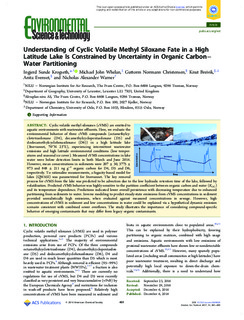| dc.contributor.author | Krogseth, Ingjerd Sunde | |
| dc.contributor.author | Whelan, Mick | |
| dc.contributor.author | Christensen, Guttorm N | |
| dc.contributor.author | Breivik, Knut | |
| dc.contributor.author | Evenset, Anita | |
| dc.contributor.author | Warner, Nicholas Alexander | |
| dc.date.accessioned | 2017-08-16T07:59:39Z | |
| dc.date.available | 2017-08-16T07:59:39Z | |
| dc.date.created | 2017-01-25T15:52:41Z | |
| dc.date.issued | 2017 | |
| dc.identifier.citation | Krogseth, I.S., Whelan, M.J., Christensen, G.N., Breivik, K., Evenset, A. & Warner, N.A. (2017). Understanding of cyclic volatile methyl siloxane fate in a high latitude lake is constrained by uncertainty in organic carbon-water partitioning. Environmental Science & Technology, 51, 401-409. doi:10.1021/acs.est.6b04828 | nb_NO |
| dc.identifier.issn | 0013-936X | |
| dc.identifier.uri | http://hdl.handle.net/11250/2450842 | |
| dc.description.abstract | Cyclic volatile methyl siloxanes (cVMS) are emitted to aquatic environments with wastewater effluents. Here, we evaluate the environmental behavior of three cVMS compounds (octamethylcyclotetrasiloxane (D4), decamethylcyclopentasiloxane (D5) and dodecamethylcyclohexasiloxane (D6)) in a high latitude lake (Storvannet, 70°N 23°E), experiencing intermittent wastewater emissions and high latitude environmental conditions (low temperatures and seasonal ice cover). Measured cVMS concentrations in lake water were below detection limits in both March and June 2014. However, mean concentrations in sediments were 207 ± 30, 3775 ± 973 and 848 ± 211 ng g−1 organic carbon for D4, D5 and D6, respectively. To rationalize measurements, a fugacity-based model for lakes (QWASI) was parametrized for Storvannet. The key removal process for cVMS from the lake was predicted to be advection due to the low hydraulic retention time of the lake, followed by volatilization. Predicted cVMS behavior was highly sensitive to the partition coefficient between organic carbon and water (KOC) and its temperature dependence. Predictions indicated lower overall persistence with decreasing temperature due to enhanced partitioning from sediments to water. Inverse modeling to predict steady-state emissions from cVMS concentrations in sediment provided unrealistically high emissions, when evaluated against measured concentrations in sewage. However, high concentrations of cVMS in sediment and low concentrations in water could be explained via a hypothetical dynamic emission scenario consistent with combined sewer overflows. The study illustrates the importance of considering compound-specific behavior of emerging contaminants that may differ from legacy organic contaminants. | nb_NO |
| dc.language.iso | eng | nb_NO |
| dc.relation.uri | http://dx.oi.org/10.1021/acs.est.6b04828 | |
| dc.title | Understanding of Cyclic Volatile Methyl Siloxane Fate in a High Latitude Lake Is Constrained by Uncertainty in Organic Carbon− Water Partitioning | nb_NO |
| dc.type | Journal article | nb_NO |
| dc.type | Peer reviewed | nb_NO |
| dc.description.version | publishedVersion | nb_NO |
| dc.rights.holder | © 2016 American Chemical Society | nb_NO |
| dc.source.pagenumber | 401-409 | nb_NO |
| dc.source.volume | 51 | nb_NO |
| dc.source.journal | Environmental Science and Technology | nb_NO |
| dc.identifier.doi | 10.1021/acs.est.6b04828 | |
| dc.identifier.cristin | 1437798 | |
| dc.relation.project | Norges forskningsråd: 222259 | nb_NO |
| cristin.unitcode | 7460,60,0,0 | |
| cristin.unitcode | 7460,57,0,0 | |
| cristin.unitname | Miljøkjemi | |
| cristin.unitname | Atmosfære og klima | |
| cristin.ispublished | true | |
| cristin.fulltext | original | |
| cristin.qualitycode | 2 | |
